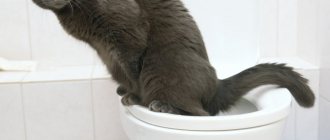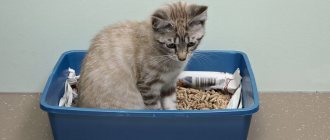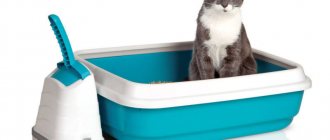Most cat owners are faced with the issue of properly organizing their cat litter box. A small bathroom does not always allow you to place a tray in it so that it does not disturb anyone. Owners are often bothered by the unpleasant odor emanating from the cat's litter box or litter granules scattered around it. There are many questions, but one solution is to train your pet to use the human toilet. Although there is an opinion that cats cannot be trained, but with a little patience and consistent implementation of the training algorithm, a cat will happily begin to use the toilet.
Benefits of using a toilet instead of a litter box
Why train an animal to use the toilet, when to maintain cleanliness in the house it is enough to regularly change the cat's litter box? On the one hand, this is true. But if you look at the benefits of letting a cat use the toilet, it becomes obvious that this method of organizing a cat’s litter box is much better. It has a number of advantages:
- There is no need to look for a convenient place for the tray so that it does not interfere or catch the attention of guests.
- No unpleasant odor. It is unlikely that the owner will clean up after the cat immediately after filling it, so the presence of an unpleasant odor, albeit temporarily, will always be present.
- Saving time on cleaning the cat litter and regular disinfection.
- Cleanliness – the toilet tray for cats has a very modest size, and no matter how clean the cat is, granules or sand will always be scattered around the tray.
- Money savings - cat litter costs money, and in order to maintain cleanliness in the tray, it is recommended to change the granules as often as possible, and this, accordingly, is a constant waste of money.
And of course, what owner of a mustachioed pet would not be pleased by the enthusiastic cries of the guests watching how the smart cat not only went to the toilet, but also flushed after himself.
Fourth step
The next step is to try to change your kitten's mentality. He needs to start doing his thing in the toilet, not in the litter box. Here are some alternatives, but all you need is a simple bowl you have at home. You can create your own sandbox using a container that you place on top of the toilet and some strong paper to support the weight of the kitten under the lid. You can also sprinkle sand to help your pet continue to feel comfortable and associate it with his old litter box.
© shutterstock
Recommendations for toilet training a cat
The owner will need to be as patient as possible. You should not expect that a cat will literally start going to the toilet within a day. The training process can take from 10 to 14 days, sometimes a little longer. During this period, the person should gradually move the tray from the pet’s usual place closer to the toilet. There is no need to be nervous if the animal initially reacts with misunderstanding to such a change of situation.
There are no age restrictions for retraining a cat. You can teach both a kitten and an adult animal to go on the toilet. But it is not recommended to train a very small kitten in this way, because there is a risk that he simply will not balance on the toilet seat and may fall.
You should not start toilet training a cat that has recently had vaccinations or castration, if the pet has recently been ill and is still quite weak or in a stressful state. It is necessary to wait until the animal’s health is fully restored and only after final recovery begin to implement the project.
If the first attempts at weaning from the litter box are unsuccessful, you should wait a few weeks or a month and try again to train your pet. The entire training procedure is divided into three stages and it is very important to follow this sequence in order for the endeavor to be crowned with success.
First stage of training
The main thing is not to rush. The tray to the toilet must be moved gradually so that the cat “smoothly” gets used to changing its position. If the toilet is immediately moved to a great distance from the usual one, the pet may refuse to go to it. But this does not mean that you need to move the tray a few millimeters, so toilet training can take many weeks.
After moving the tray to a new location, it is recommended to wait a couple of days until the cat gets used to the new location. As soon as the pet stops experiencing discomfort from the new location of its toilet and goes to it without problems, it can be moved further.
If the first stage is problematic, you can use a special spray with a scent that attracts cats. You can buy it at any pet store. Every time your cat goes to the litter box, you can reward it by petting it or giving it a favorite treat or treat. However, if an “embarrassment” occurs, you should under no circumstances scold the animal for it.
Second phase
When the cat litter box is located directly next to the toilet, and the pet goes on it without problems, you can proceed to the second stage - raising the cat litter box to the level of the toilet bowl. To do this, you will need several stands or benches with different heights. Every day the tray should rise 5 cm higher, positioning itself closer to the toilet seat.
The toilet lid must always be open. This is necessary so that the cat gets used to this type of toilet. Naturally, a cat's curiosity will always take over, and the pet will definitely look into the toilet.
It is recommended that the owner provide a stand for the tray so that it is strong and stable enough. After all, if a pet falls from such a “pedestal” at least once, the likelihood that he will want to use it again is zero.
When raising the tray higher, you need to carefully monitor the behavior of your pet. Some animals quickly get used to changing the position of the tray, while others may experience some inconvenience. It is important to make sure that the cat does not feel discomfort, because if the animal is constantly uncomfortable, training can be given up.
Third stage
At the moment when the tray is level with the toilet, and the cat can calmly walk on it, you can begin the final stage. First, it is recommended to sprinkle a little litter on the toilet seat so that the cat sees and realizes that where the granules are scattered is his toilet.
At this stage, special attractive aerosols will again help speed up the process. At the final stage of training, the tray is placed directly into the toilet. It is important to monitor how your pet's paws are positioned when he goes to the tray. All four paws should be clearly on the toilet seat.
You also need to gradually place the tray in the toilet. First, the cat litter should be moved a quarter towards the toilet, then halfway, and only then can it be lowered completely. When the cat went to the litter tray in the toilet for the first time, you should not be prematurely happy and rush to clean it up. The animal should go to the litter box regularly for several days. If these actions do not cause discomfort to the cat, the tray can be removed.
CitiKity simulator
The essence of this simulator is that it includes plastic in the form of a tray and there are 7-8 sections on it. That is, the question of how to train a cat to pee on the toilet can be resolved in 7-8 weeks. This tray should be placed under the baby cat and covered with cat sand, and then left there for a week.
You need to train the cat to jump in there. After a week, you need to cut out the first section - the smallest circle that is in the middle. The cat continues to get used to walking.
- After a week, cut out even more. Eventually, when there are no sections left at all, you will end up with a healthy hole. Thus, the animal learns to relieve itself in the toilet on its own. If you teach it from two months, it takes about a year and a half.
- The instructions say that you can train from 6 months, but the sooner you do this, the better, because the older the cat gets, the more difficult it is to influence him.
- During this time, there will be cases when the cat will go the wrong way, relieve itself in all corners, for which it needs to be punished. This punishment lasts for a week, after which everything is repeated, but patience is important here.
- Teaching a cat to go to the toilet is not an easy job, but at the same time, it is an opportunity to study his habits, character, and behavior.
In the future, the owner will already know that if a cat, for example, rushes around the apartment and meows loudly, this means that he wants it big. If he starts clinging to the carpet with his paws and spinning around the wall, it means that he wants something small.
Useful devices
If no difficulties arise with moving the tray from its usual location, then certain difficulties may arise with organizing the pedestal to gradually raise it to the height of the toilet. Many people wonder what exactly to place under the tray in order to regularly change its height.
For this purpose, you can use special systems designed specifically to train a cat to use the toilet. But even here there are a number of difficulties. Finding toilet training systems is problematic, and their cost is not that affordable.
When the cat begins to go to the toilet, difficulties again arise in order to gradually move the tray along the toilet. The likelihood that it will not support a quarter of its surface area on the toilet is quite high. Owners have to get creative by placing a chair under the tray or using sticky/adhesive tape. You can simplify these actions by using special toilet seat covers, but here another problem emerges - searching in stores and high prices.
What is the cost of training?
The most affordable single toilet seat for cats. You can buy it for 1.5 – 2.0 thousand rubles. The cost depends on the manufacturer and material of manufacture.
A system for toilet training cats will cost more. You can buy it for about 3 thousand rubles. But such devices can be purchased completely free of charge: you are quite capable of using a system for training a cat to use the toilet with your own hands.
Please note: prices from domestic and foreign manufacturers are virtually the same.
The biggest hit to your pocket is the automatic device - the toilet for the cat. You can buy one for several thousand rubles.
Recommendations
When many days of efforts are crowned with success, and the pet begins to go to the toilet, the owners must follow certain recommendations and advice:
- The door to the toilet room should always be slightly open so that the animal can enter at the right moment.
- The toilet lid must not be lowered. If the cat is unable to sit on the toilet because the lid is down, an “accident” may occur and the cat will no longer go to the toilet.
- No matter how clean cats or cats may be, they are still animals, and owners must observe hygienic and sanitary standards when visiting the toilet with a cat. The toilet seat should be wiped regularly with disinfectants. It is recommended to do this at least once every two days, and ideally every day, in the evening or in the morning.
On the Internet you can find and watch many videos on how to quickly train a cat to use the toilet. But the owner of a furry four-legged friend must understand that everything may not work out as quickly and simply as described in the video.
All cats are individual, have different characters, and therefore it will take one week to train one animal, and much longer for another. The main thing is to be patient, not to push him and not to punish him for failures or unwillingness to obey the owner’s new demands.
Final tips
When a cat learns to relieve itself in the toilet, it will be important to follow some rules:
- Leave the toilet door slightly open so that the cat can pass through without any problems.
- The toilet seat cannot be lowered. The cat should relieve itself without hindrance
It is recommended to create a diet and track when the cat relieves itself after eating. The owner can adjust this mode to suit his schedule.











